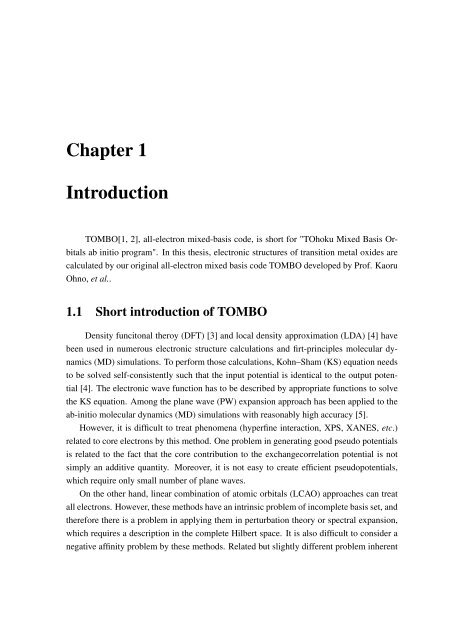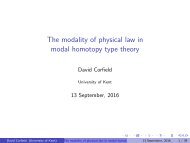TOMBO Ver.2 Manual
TOMBO
TOMBO
Create successful ePaper yourself
Turn your PDF publications into a flip-book with our unique Google optimized e-Paper software.
Chapter 1<br />
Introduction<br />
<strong>TOMBO</strong>[1, 2], all-electron mixed-basis code, is short for "TOhoku Mixed Basis Orbitals<br />
ab initio program". In this thesis, electronic structures of transition metal oxides are<br />
calculated by our original all-electron mixed basis code <strong>TOMBO</strong> developed by Prof. Kaoru<br />
Ohno, et al..<br />
1.1 Short introduction of <strong>TOMBO</strong><br />
Density funcitonal theroy (DFT) [3] and local density approximation (LDA) [4] have<br />
been used in numerous electronic structure calculations and firt-principles molecular dynamics<br />
(MD) simulations. To perform those calculations, Kohn–Sham (KS) equation needs<br />
to be solved self-consistently such that the input potential is identical to the output potential<br />
[4]. The electronic wave function has to be described by appropriate functions to solve<br />
the KS equation. Among the plane wave (PW) expansion approach has been applied to the<br />
ab-initio molecular dynamics (MD) simulations with reasonably high accuracy [5].<br />
However, it is difficult to treat phenomena (hyperfine interaction, XPS, XANES, etc.)<br />
related to core electrons by this method. One problem in generating good pseudo potentials<br />
is related to the fact that the core contribution to the exchangecorrelation potential is not<br />
simply an additive quantity. Moreover, it is not easy to create efficient pseudopotentials,<br />
which require only small number of plane waves.<br />
On the other hand, linear combination of atomic orbitals (LCAO) approaches can treat<br />
all electrons. However, these methods have an intrinsic problem of incomplete basis set, and<br />
therefore there is a problem in applying them in perturbation theory or spectral expansion,<br />
which requires a description in the complete Hilbert space. It is also difficult to consider a<br />
negative affinity problem by these methods. Related but slightly different problem inherent



